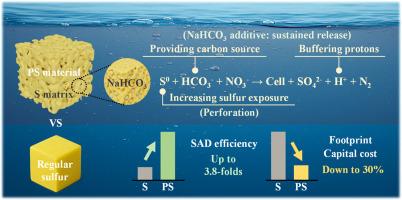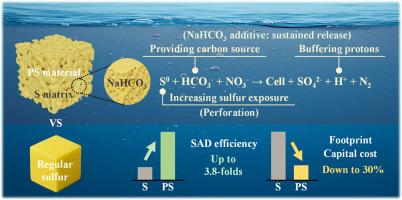多孔硫复合材料内置缓冲解锁高效自养反硝化跨水碱度制度
IF 12.4
1区 环境科学与生态学
Q1 ENGINEERING, ENVIRONMENTAL
引用次数: 0
摘要
硫基自养反硝化(SAD)是一种高效、无碳的脱氮途径,但单质硫的生物利用度低,在低碱度条件下适应性差。本研究采用nahco3辅助熔融冷却造粒法合成多孔硫基(PS)材料,集结构穿孔和内在缓冲于一体。NaHCO3在制造过程中作为射孔剂,在使用过程中作为持续的碱度来源。结构表征表明,初级射孔形成了相互连接的大孔,便于微生物定殖,而次级射孔在NaHCO3/Na2CO3逐渐溶解的驱动下,在作业过程中扩大了孔隙度。性能测试表明,在高碱度和低碱度条件下,PS材料的硝酸盐去除率都是原料硫的1.3-3.8倍。大于500 nm的大孔体积与反硝化速率的相关性强于比表面积(R2 = 0.85 vs. 0.65)。PS材料也能丰富硫杆菌,并在其生命周期内持续释放碱度。硫碱度平衡分析为不同进水条件下的材料选择提供了框架。从工程角度来看,PS材料可以将生物过滤器体积减少74%,降低资本成本和土地使用,尽管运营成本略有上升。这些发现促进了对功能介质的结构-功能理解,并支持可扩展SAD应用的特定场景材料策略。本文章由计算机程序翻译,如有差异,请以英文原文为准。


Porous sulfur composites with built-in buffering unlock high-efficiency autotrophic denitrification across water alkalinity regimes
Sulfur-based autotrophic denitrification (SAD) offers an efficient, carbon-free route for nitrogen removal, yet suffers from the low bioavailability of elemental sulfur and poor adaptability under low-alkalinity conditions. This study presents a porous sulfur-based (PS) material synthesized via NaHCO3-assisted melt-cooling granulation, integrating structural perforation and intrinsic buffering. NaHCO3 served both as a perforation agent during fabrication and a sustained alkalinity source during use. Structural characterization revealed primary perforation formed interconnected macropores for microbial colonization, while secondary perforation, driven by gradual NaHCO3/Na2CO3 dissolution, expanded porosity during operation. Performance testing showed PS materials achieved nitrate removal rates 1.3–3.8 times those of raw sulfur across both high- and low-alkalinity conditions. The volume of macropores greater than 500 nm exhibited a stronger correlation with the denitrification rate than the specific surface area (R2 = 0.85 vs. 0.65). PS materials also enriched Thiobacillus and sustained alkalinity release over their lifespan. A sulfur-alkalinity balance analysis provided a framework for material selection under different influent conditions. From an engineering perspective, PS materials could reduce biofilter volume by up to 74 %, lowering capital cost and land use despite a modest rise in operational cost. These findings advance the structure-function understanding of functional media and support scenario-specific material strategies for scalable SAD application.
求助全文
通过发布文献求助,成功后即可免费获取论文全文。
去求助
来源期刊

Water Research
环境科学-工程:环境
CiteScore
20.80
自引率
9.40%
发文量
1307
审稿时长
38 days
期刊介绍:
Water Research, along with its open access companion journal Water Research X, serves as a platform for publishing original research papers covering various aspects of the science and technology related to the anthropogenic water cycle, water quality, and its management worldwide. The audience targeted by the journal comprises biologists, chemical engineers, chemists, civil engineers, environmental engineers, limnologists, and microbiologists. The scope of the journal include:
•Treatment processes for water and wastewaters (municipal, agricultural, industrial, and on-site treatment), including resource recovery and residuals management;
•Urban hydrology including sewer systems, stormwater management, and green infrastructure;
•Drinking water treatment and distribution;
•Potable and non-potable water reuse;
•Sanitation, public health, and risk assessment;
•Anaerobic digestion, solid and hazardous waste management, including source characterization and the effects and control of leachates and gaseous emissions;
•Contaminants (chemical, microbial, anthropogenic particles such as nanoparticles or microplastics) and related water quality sensing, monitoring, fate, and assessment;
•Anthropogenic impacts on inland, tidal, coastal and urban waters, focusing on surface and ground waters, and point and non-point sources of pollution;
•Environmental restoration, linked to surface water, groundwater and groundwater remediation;
•Analysis of the interfaces between sediments and water, and between water and atmosphere, focusing specifically on anthropogenic impacts;
•Mathematical modelling, systems analysis, machine learning, and beneficial use of big data related to the anthropogenic water cycle;
•Socio-economic, policy, and regulations studies.
 求助内容:
求助内容: 应助结果提醒方式:
应助结果提醒方式:


